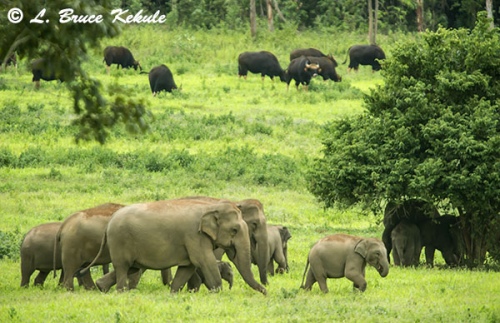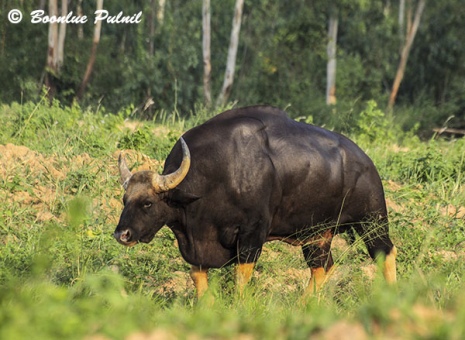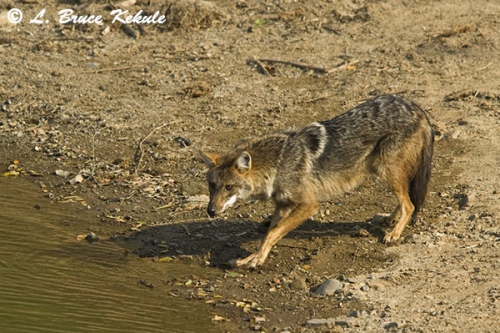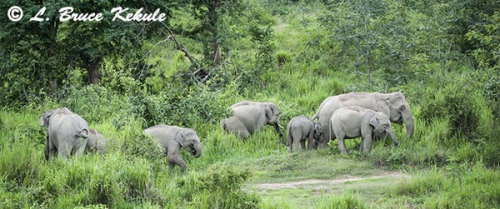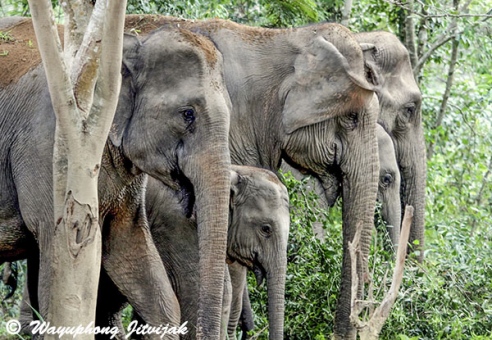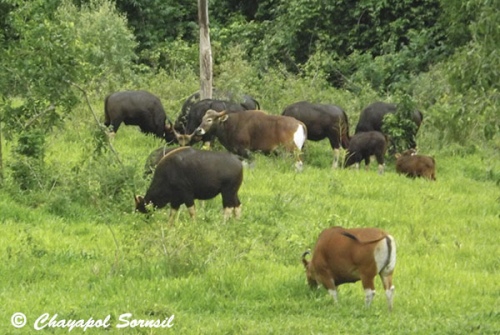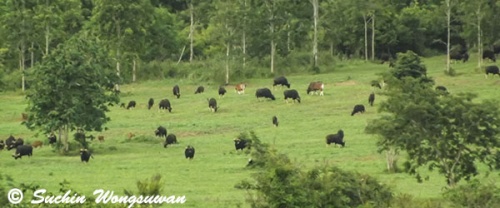Kuiburi National Park: Natural evolution in Southwest Thailand
Home to wild elephant and gaur:
Elephants and gaur just after a rain in the grassland
“Wild elephants should live here in the wild, but the forest must be restored to a state in which it is able to be a source of sufficient food. We must dedicate small plots of land throughout the forest that will serve as food sources. Moreover, elephants must be protected when roaming near the forest edge.”
His Majesty King Bhumibol Adulyadej on July 5, 1999 said on the management of the human-elephant conflict in Kuiburi National Park
A gaur bull in the grassland
Just about every afternoon, a natural phenomenon has evolved into one of Thailand’s greatest wildlife shows. A savannah or grassland situated in Kuiburi National Park in the southwest province of Prachuap Kirikhan provides a backdrop for sighting three of the Kingdom’s majestic wild animals.
Elephants, gaur and banteng seen in daylight are rare occurrences in other protected areas around the country but not here. Due to increased attention, conservation, research, funding and better protective enforcement management, the park is now world famous as a place to see these creatures. Even a tiger was recently seen here in broad daylight.
Asiatic jackal at one of eleven waterholes
This has taken place because many people now see the important aspect and value of protecting Thailand’s natural resources for the world to see. Conservation success stories are as rare as intact ecosystems and our precious wildlife. Kuiburi has become a role model for wildlife conservation in the nation.
His Majesty the King and Her Majesty Queen Sirikit have taken a special interest in Kuiburi from the early 1970s when Their Majesties provided assistance in the construction of the Yang Chum earthen irrigation dam in Kuiburi. Through their guidance in 1979, this Royal Project when completed provided access to 32 million cubic meters of water for the lowland people.
Elephant herd in late afternoon near a waterhole
After a big flood in 1996, the dam’s height was raised two meters with His Majesty providing funding to restrain more water. This was the first dam in Thailand that used earthen material from the United States to raise dam height. Water volume was increased another 9 million cubic meters and still operates to this day providing water for farming and subsidence to the people in the province.
His Majesty was also instrumental in coaxing villagers and farmers out of Kuiburi in the early 1990s, and in 1999 the protected area was finally established as a national park encompassing an area of 969 square kilometers. A large portion of the interior had already been cleared for agriculture with pineapples as the main crop plus sugar cane, vegetables, and several pine and eucalyptus tree plantations. Many people-elephant conflicts arose to become a serious problem for all. The degradation was quite severe but the park was saved just in the nick of time due to His Majesty’s efforts.
Elephant in a waterhole cooling off
Chalerm Yoovidhya of ‘Red Bull’ fame and owner of Siam Winery, has financed many projects improving the habitat for elephants and wild cattle. His first efforts were to develop firebreaks during drought periods and build check-dams in some streams to provide water in case of forest fire.
Another very important program implemented by his team and headed by Chayapol Sornsil has also improved salt licks and the grassland that attract these huge herbivores. Other programs like helping the rangers with food and equipment for patrolling has been undertaken. Chalerm recently started the ‘Thai Gaur Conservation Group’ based just outside the park. He is also organizing a foundation to help the infrastructure, up-keep of the grasslands and other important issues like the patrol rangers.
Banteng cow, mynhas and gaur in Kuiburi
Another important partner is the World Wildlife Fund (WWF) Thailand who has also been very busy with many projects in Kuiburi including helping the elephant-people conflict plus doing research and camera trapping in the interior to see what has survived the onslaught of poaching and encroachment over the years. Illegal hunting still goes on but now on a very limited scale. It is a tough one to stamp out completely but under proper guidance and supervision with ‘Outreach’ programs, there is a chance for zero poaching and no encroachment over the long run. They have also been involved in the grassland, salt lick and check-dam projects.
According to Dr Robert Steinmetz with WWF, there are five confirmed tigers and probably more, plus a multitude of other carnivores and prey species. Rare animals like tapir, Fea’s muntjac, clouded leopard plus Asiatic jackals, black bear, sun bear, golden cat among others has also been camera trapped by Robert. Wayuphong Jitvijak, also with WWF, has been extremely busy coordinating with the park’s personnel and local villagers on conservation, especially with the elephants.
Elephants in an old eucalyptus plantation
The most important aspect was the establishment of the grassland just a short four years ago that was compatible with wildlife. Huge areas of invasive Guinea grass (Megathyrsus maximus var maximus) that is not suitable to wildlife were removed, and replaced with Ruzi grass (Brachiaria ruziziensis), a species that elephants, gaur and banteng can live on and propagate. More than 12,000 Rai has been developed. Major funding from the National Lottery Bureau and grass seed from the Department of Livestock in conjunction with more funding from Siam Winery and WWF has been invested.
Another man has also been a very important asset for Kuiburi. He is Boonlue Pulnil, a former superintendent here who took a vested interest in the continued existence of the park. He managed to get funding to establish 11 waterholes that now provide water for the animals especially during drought periods. He still works for the Department of National Parks (DNP) and with several NGOs and groups on improving Kuiburi’s ecosystems and the wildlife. One such group is the Foundation for the King’s Wild Elephant.
Tiger photographed near the grassland in Kuiburi
Other people have taken an interest in Kuiburi’s long-term survival. The present chief of Kuiburi, Cholathorn Chamnankid is actively involved in improving protection and enforcement with a program of wildlife conservation and zero poaching. Other dignitaries include the Governor of Prachuap Khirikan, Weera Sriwathanatrakoon, who has been at the forefront of protecting Kuiburi. General Noppadol Wathanotai, advisor to His Majesty’s Projects, Office of the Principal Private Secretary is also working with the group. Kuiburi District Chief Officer Phongphan Wichiansamut, an avid nature fan, is supporting all activities on wildlife conservation and protecting the park for the future.
In July 2012, a MOU singing ceremony between the main agencies in Kuiburi including the Royal Thai Army (First Army Area of Thailand), Border Patrol Police Bureau and Provincial Police Operation Center made a dedicated effort in the province supporting the Tenasserim Agreement at Yang Chum Dam. These conservation results are positive showing a 100 percent increase in both populations of gaur and elephants. The grassland north of the headquarters is the key.
Mixed banteng and gaur herd in the savannah
Due to its status and improvement in awareness from near extinction to herds of about 250 elephants and more than 150 gaur, the road to recovery is positive. These amazing animals are now thriving very well, mainly around the savannah. Banteng however, is still highly endangered here with just a few individuals remaining including two mature bulls and one cow sighted mixing with gaur. It is hoped there are more banteng in the interior.
The need to protect these forests and wildlife in the lower Tenasserim Range is of vital importance. In the old days before roads, Kuiburi, Practakor reserved forest and Kaeng Krachan National Park to the north was all connected by naturally occurring corridor of thick rainforest along the border with Burma by these mountains.
Some 50 years ago, Thung Plai Ngam – a hunter’s paradise – was a favorite place of the rich to go on hunting trips. It is situated behind Pranburi reservoir but is now completely void of wildlife. Back then there were crocodiles in the river and large herds of elephant, rhino, gaur and tiger were common. Kuiburi was famous for its tigers in the old days.
The grassland success in Kuiburi National Park
As humans built roads and expanded into virgin forests after wood and other resources, agriculture and villages followed and replaced the jungle. All the classic Asian animals and ecosystems were systematically wiped out in man’s eager quest to survive. It is impossible to get all this back but it is imperative that the remaining patches of forest and wildlife must be saved and protected to the full extent of the law.
One of the most important aspects of wildlife conservation is to educate the people on the importance of saving Kuiburi for future generations and the world to see. Also, to keep any expansion in the park to an absolute minimum, and make sure the rangers undertake constant patrols, and arrest and put law-breakers behind bars for long periods of time. It is a fact! With zero poaching and no encroachment, the forest and wildlife will come back over time.
It now seems that Kuiburi is a special place in Thailand, and we all should be proud of the people who are or have been involved it its continued survival. They should be commended for their efforts. It has made the difference and the Kingdom’s natural heritage has recoved from near extinction to this. Finally, constant pressure must be applied to all aspects of protecting the Kuiburi forests so generations to come will see the heroes and successes of today..!


